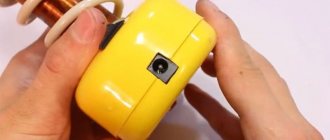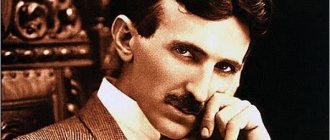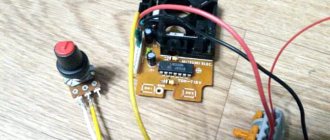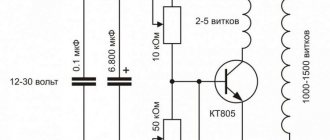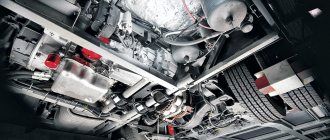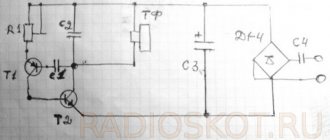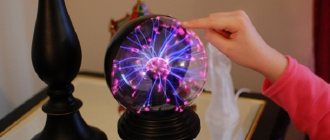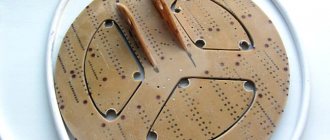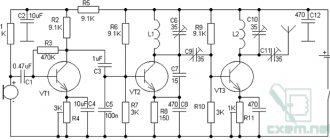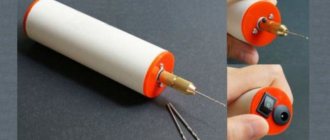Solving the problem of wireless transmission of electrical energy over long distances is a long-standing dream of mankind. You can imagine how much cheaper electricity would be without the cost of conductive products. The scientific and technological revolution does not stand still. There is hope that this dream will come true in the near future. This is evidenced by new developments in this area.
Humanity's dream is wireless transmission of electricity
What it is?
The coil is a transformer. The purpose of the device is to increase current parameters to enormous heights (up to millions of volts). Main Goal: Maximize AC frequency. Ideally, the same return coil should be placed at the energy receiving point, which will resonate with the device, allowing energy to be transferred over a distance.
Contactless energy transfer through a Tesla coil
Let's take a closer look at how a Tesla coil works. First, let’s swing - it’s not immediately clear what’s swinging in the coil. Direct current, which Edison used in his inventions, is expensive to produce. This energy has a pronounced vector of movement. Alternating current constantly changes the parameters of electricity: voltage and current. This is called electrical current fluctuations.
It is interesting that the basic laws of oscillation of an electric current and a mechanical pendulum coincide. Interestingly, there is also a resonance effect for electricity. When the frequencies of the two electric fields coincide, the amplitude of the oscillations increases. According to Tesla's idea, after the coils resonate, an electric current should appear in the receiver.
In fact, the receiver was never invented. The Tes coil is used as a reference, on it you can see the flow: in other words, the electric arc, the current discharge, artificial lightning and study the wireless transmission of electricity.
Theory
Wireless electricity is literally the transfer of electrical energy without wires. People often compare the wireless transmission of electrical energy with the transmission of information, such as radios, cell phones, or Wi-Fi Internet access. The main difference is that radio or microwave transmission is a technology aimed at restoring and transporting information, and not the energy that was originally expended on transmission.
Wireless electricity is a relatively new area of technology, but one that is developing quite dynamically. Methods are now being developed to efficiently and safely transmit energy over a distance without interruption.
Basic elements of an electricity generating plant
Two-element installation: oscillating and receiving. The first element is a Tesla transformer, which is powered by the IR2153 chip. The Kacher will operate at 230 kilohertz, running on a 23 kilohertz chip. There will be 2 field-effect transistors at the output. The coil is wound with 0.35 mm copper wire. 950 rpm. Almost all the details are there. The only drawback is the diet. In the following video you can see how the device turned out. This Chinese store sells ready-made rolls.
The other part of the diagram is more complex. It will be more expensive. Rare ferrites are used. But the game is worth the candle. The circuit completely does not correspond to the usual concepts of physics and electronics.
History of development
The development of remote wireless transmission of electricity is associated with advances in radio technology, since both processes are of the same nature. Inventions in both areas are associated with the study of the method of electromagnetic induction and its effect on the generation of electric current.
In the morning of 1820, Ampere discovered the law of interaction of currents, which was that if a current flows in the same direction through two closely located conductors, then they attract each other, and if they are in different directions, they repel.
M. Faraday in 1831 established through experiments that an alternating magnetic field (which changes size and direction over time) created by the flow of electric current induces (induces) currents in adjacent conductors. Those have wireless power transmission. We discussed Faraday's law in detail in a previous article.
So, J.C. Maxwell 33 years later, in 1864, translated Faraday’s experimental data into mathematical form; the same Maxwell equations are fundamental in electrodynamics. They describe how electric current and electromagnetic field are related.
The existence of electromagnetic waves was confirmed in 1888 by G. Hertz during his experiments with a spark emitter with a switch on a Ruhmkorff coil. In this way, electromagnetic waves with a frequency of up to half a gigahertz were created. It is worth noting that these waves could be received by multiple receivers, but they must be tuned in resonance with the transmitter. The range of the plant was about 3 meters. When a spark occurred in the transmitter, the same spark occurred in the receivers. In fact, these are the first experiments in wireless power transmission.
The famous scientist Nikola Tesla conducted extensive research. He studied high voltage and frequency alternating current in 1891. As a result, the following conclusions were made:
For each specific purpose, the installation must be set to the appropriate frequency and voltage. In this case, high frequency is not a prerequisite. The best results were obtained at a frequency of 15-20 kHz and a transmitter voltage of 20 kV. An oscillatory capacitor discharge was used to produce high frequency current and voltage. In this way, both electricity can be transmitted and light can be produced.
During his speeches and lectures, the scientist demonstrated the glow of lamps (electron tubes) under the influence of a high-frequency electrostatic field. In fact, Tesla's main conclusions were that even with resonant systems, it is impossible to transfer much energy using an electromagnetic wave.
In parallel, a number of scientists were engaged in similar research until 1897: Jagdish Boche in India, Alexander Popov in Russia and Guglielmo Marconi in Italy.
Each of them contributed to the development of wireless energy transmission:
- J. Bosch ignited gunpowder in 1894, transmitting electricity over a distance without wires. He did this during a demonstration in Calcutta.
- A. Popov transmitted the first message using Morse code on April 25 (May 7), 1895. In Russia today, May 7, is still Radio Day.
- In 1896, G. Marconi in Great Britain also transmitted a radio signal (Morse code) to a distance of 1.5 km and then 3 km over Salisbury Plain.
It is worth noting that Tesla’s work, underestimated in its time and lost for centuries, surpassed the work of his contemporaries in terms of parameters and power. At the same time, it was in 1896 that his devices transmitted a signal over long distances (48 km), but, unfortunately, it was a small amount of electricity.
And in 1899 Tesla came to the conclusion:
The failure of the induction method seems enormous in comparison with the method of exciting the charge of the earth and air.
This finding would lead to other research: in 1900 he was able to power a lamp from a coil in the field, and in 1903 the Vandercliffe Tower on Long Island was launched. It consisted of a transformer with a grounded secondary winding and a spherical copper dome on top. With his help, it turned out that 200 50-watt lamps were lit. At the same time, the transmitter was 40 km away. Unfortunately, this research was stopped, funding was suspended, and free wireless transmission of electricity was not economically viable for business people. The tower was destroyed in 1917.
Mysterious genius
| Inventor, physicist, mathematician Nikola Tesla was clearly born in the wrong century. If this had happened at least fifty years later, the world could have changed forever. |
The life of inventor Nikola Tesla, born in Croatia (formerly part of Austria-Hungary), cannot be called simple. Like many other scientific inventors, he had to face many difficulties, underfunding and misunderstanding. Tesla's ingenious inclinations first appeared at a higher school in the city of Graz, where a student expressed his dissatisfaction and pointed out the imperfections of electric motors based on direct current. The ideas of the young scientist were immediately criticized by Professor Yakov Peschl - in his lecture before the course, he openly stated that electric motors based on alternating current are impossible. On the same day, Tesla solemnly vowed to convince his mentor at all costs and devote his life to studying the properties of electricity and magnetism.
After finishing his studies, Nikola had to move back to Gospić and get a job as a teacher at a gymnasium - after the death of his father in 1879, the family’s financial situation was greatly shaken. Further attempts to enter a higher education institution turned out to be a failure; there was no money.
For several more years, Tesla worked as an electrical engineer at the Hungarian Government Telegraph Company in Budapest and even managed to correct a number of errors and shortcomings during the construction of a power plant for the railway station in Strasbourg. Workdays, of course, interfered with work on the main dream of those years - an electric motor based on alternating current: Tesla tried to work on his developments in parallel, but there was not enough time. A working prototype of an AC electric motor was shown to several entrepreneurs, but no one was interested. Disappointed, Tesla was even planning to leave for St. Petersburg, where outstanding physicists Pavel Yablochkov, Dmitry Lachinov and Vladimir Chikolev worked (the works of Russian inventors were known all over the world and were cited in scientific journals in different languages). And perhaps the scientist’s fate would have turned out differently if one of the administrators of the Continental Edison Company
, Charles Batchelor, did not persuade him to go to the USA. In his note to the greatest American inventor, Thomas Edison, Mr. Batchelor said that letting Nikola go to Russia would be an unforgivable mistake, calling him the second great man after Edison.
The note had exactly the opposite effect: Edison’s relationship with Tesla was ruined even before they met. They say that the American genius saw a serious competitor to his business and did everything possible to humiliate his work: he spoke coldly about his work and even publicly criticized it. The final break in relations was Edison’s “business proposal” in the spring of 1885 - the inventor suggested that Nikola constructively improve the DC machines he had created and promised $50 thousand (about $1 million today) if successful. Encouraged, Tesla presented as many as 24 significantly improved machines, a new switch and regulator with improved performance, but he never received his money - Edison only laughed at his younger colleague and advised him to learn to understand American humor. Edison's "joke" became the beginning of a feud between two geniuses, which never went away over time.
| The unfinished Tesla Tower remained in the New York area until 1917, when the government suspected that German spies were using it to send information. The tower was blown up. | The mutant girl Storm from the X-Men comics could not only control the weather, but also charge the mobile phones of her colleagues with the power of her thoughts. |
| Myths or reality? |
The name of Nikola Tesla is associated with many secrets and mysteries. Contemporaries did not know many details of the biography of the great inventor, but history preserved very mysterious references to his name in connection with strange phenomena. Thus, the mysterious Tunguska meteorite, which allegedly exploded in the air above the Podkamennaya Tunguska River on June 17, 1908, is attributed to the eccentric nature of Nikola Tesla. Indirect confirmation of the inventor's involvement in the Siberian disaster are experiments with powerful weather installations and a request for maps of Siberia, which was made by Nikola around the same time.
Nikola Tesla is said to have demonstrated a compact electric motor in 1931 with the support of General Electric.
and
Pierce-Arrow
- in front of the amazed public, Tesla installed a strange box with two protruding rods under the hood of the car, and then, having connected all the wires, the inventor got into the car and drove off. If you believe the rumors, Tesla himself claimed that the energy in this case was taken from a certain “ether,” the so-called energy field of the Earth.
The inventor often said that he did not come up with all the ideas and inventions - they came to him while falling into a trance state and walking in the park. In this case, whose hands belong to the brilliant discoveries of the scientist? They say that after his death, one of Tesla's diaries was accidentally bought at a book market - and, to his great surprise, the buyer found in it data about hostile extraterrestrial civilizations... who really was Nikola Tesla?
Coil device
The Tesla transformer, the diagram of which will be presented below, consists of two coils, a toroid, a protective ring and, of course, grounding.
TC desktop sketch
Each element must be considered separately:
- secondary winding. For winding, enameled copper wire with 800 turns is used. Therefore, the coils do not unwind and are not scratched;
- grounding If you turn on an ungrounded coil, streamers (current discharges) will not enter the air, but will create a closed circuit.
- the primary winding is located at the bottom. It is supplied with power. It must be grounded. Made of low strength metal;
- toroid. This element reduces the resonant frequency, stores energy and increases the operating range.
- protective ring. This is an open ring made of copper wire. Set if the length of the braid is greater than the length of the secondary winding;
TC drawing
Eggplants and breastfeeding
You are a young nursing mother, and you are concerned about the issue of health care. After all, as during pregnancy, during lactation the health of the baby directly depends on the health of the mother. And nutrition is a factor that significantly influences the health and well-being of every person. During this no less responsible and exciting period in the life of every woman, nutritionists and breastfeeding specialists recommend that “newly made” mothers eat enough fruits and berries - the first suppliers of vitamins and other useful substances to our body. Their consumption should be moderate.
Eggplant is especially useful for a nursing mother, because among all the vegetables, berries and fruits given to us in the fall, due to its beneficial properties, it is safer for the mother and her baby. Eggplant contains a lot of fiber, magnesium, potassium, vitamins C and B, iron, phosphorus, folic acid, copper, carotene. And this is not the entire list of substances, minerals and organic acids contained in the little blue ones, as we popularly call them, so important and irreplaceable for the health of the child and his nurse. So this product should definitely be included in the diet of a young mother.
During breastfeeding, beneficial substances from eggplants pass into milk.
Nursing mothers can eat eggplant only during its ripening period - August - September. You should not buy this berry at other times of the year, the naturalness of which remains in question. To avoid allergies in your child, like any other colored product, eggplants should be added to your menu gradually, while monitoring your infant. Eat blueberries in small quantities, and then watch your child for three days. If after this time you do not notice the appearance of acne, rashes or other allergic reactions on your baby’s skin, you can safely eat eggplant as usual.
Security measures
Once your CT is assembled, there are a few precautions to take before launching. First you need to check the wiring in the room where you plan to connect the transformer
Secondly, check the insulation of the windings.
It is also worth remembering the simplest precautions. The average voltage of the secondary winding is 700A, 15A per person is already deadly
In addition, it is worth moving all electrical appliances away; if they get into the range of the coil, they can burn out.
CT is a revolutionary discovery of its time, which is underestimated today. Today the Tesla transformer is used only for the entertainment of home electricians and in light displays. You can make a coil yourself using available tools. You will need a PVC pipe, several hundred meters of copper wire, a couple of meters of copper tubing, a transistor and a couple of resistors.
Microwave
Is there really no other truly effective way to wirelessly transmit electricity? Yes, and this was invented before children tried and played Star Wars.
It turns out that special microwaves 12 cm long (frequency 2.45 GHz) are transparent to the atmosphere and do not interfere with their propagation.
No matter how bad the weather, you will only lose five percent when broadcasting using microwaves! But to do this, you must first convert electrical current into microwaves, then capture them and return them to their original state.
Scientists solved the first problem a long time ago. For this purpose, they came up with a special device and called it a magnetron.
Moreover, it was done so professionally and safely that today each of you has such a device at home. Go to the kitchen and look at your microwave.
Inside is the same magnetron with an efficiency of 95%.
But how to do the reverse transformation? And here two approaches have been developed:
- American
- Soviet
In the United States in the 1960s, scientist W. Brown invented an antenna that performed the required task. That is, it converted the incident radiation back into electric current.
He also gave it his name - rectenna.
After the invention, experiments followed. And in 1975, using a rectenna, up to 30 kW of power was transmitted and received over a distance of more than a kilometer. Transmission losses were only 18%.
Nearly half a century later, this experience has never gotten old. It would seem that the method has been found, so why weren’t these rectennas thrown into the masses?
And here again the shortcomings appear. Rectennas are assembled on the basis of miniature semiconductors. Normal operation for them is to transmit power of only a few watts.
And if you want to transmit tens or hundreds of kilowatts, then get ready to assemble giant panels.
And here the same insoluble difficulties arise. Firstly, this is re-radiation.
Because of this, you will not only lose some of your energy, but also will not be able to approach the panels without losing your health.
The second headache is the instability of semiconductors in the panels. It is enough to burn one due to a slight overload, and the rest fail like an avalanche, like matches.
In the USSR everything was somewhat different. It was not for nothing that our military was confident that even in the event of a nuclear explosion, all foreign equipment would immediately fail, but Soviet equipment would not. The whole secret is in the lamps.
At Moscow State University, two of our scientists, V. Savin and V. Vanke, developed the so-called cyclotron energy converter. It has decent dimensions, as it is assembled using lamp technology.
Externally, it is something like a tube 40 cm long and 15 cm in diameter. The efficiency of this lamp unit is slightly lower than that of an American semiconductor element - up to 85%.
But unlike semiconductor detectors, a cyclotron energy converter has a number of significant advantages:
- reliability
- high voltage
- overload resistance
- without re-irradiation
- low production cost
However, despite all of the above, it is the methods of implementing semiconductor design that are considered advanced throughout the world. There is a fashion element here too.
After the first appearance of semiconductors, everyone began to sharply abandon tube technology. But practical tests show that this is often the wrong approach.
Of course, no one is interested in cell phones or 20-kilogram tube computers that take up entire rooms.
But sometimes only proven old methods can help us in hopeless situations.
As a result, today we have three options for wireless power transmission. The first one considered is limited by both distance and power.
But this is enough to charge the battery of a smartphone, tablet or something larger. Although the efficiency is low, the method still works.
Laser technology is only good in space. On the surface of the earth this is not very effective. True, when there is no other choice, you can use it.
But microwave ovens give free rein to the imagination. With their help you can transfer energy:
- on earth and in space
- from the surface of the earth to a spacecraft or satellite
- and vice versa, from a satellite in space it returns to Earth
The harm of electromagnetic radiation has not been proven. And will not be refuted
This is the most interesting question, to which there is a specific answer only with certain devices and boundaries. Of course, Qi-chargers for gadgets are completely safe.
Even the most powerful copies available for retail purchase are operational only at a short distance: the radiation power should not exceed 50 mW/cm2 at a distance of 20 cm from charging.
True, there is a subtlety: the distance and power on it are limited by the rules of the Communications Commissions (different countries). Since assumptions about possible harm exist, but have not been clearly established.
The radiation practically does not penetrate further due to its properties: the electromagnetic radiation of the coil with current propagates in a ring shape, forming a closed circuit.
Directional radiation requires other frequencies, other powers, and other types of radiation. The harm of which, by the way, has been studied a little more.
Low-power radio transmitting devices, in particular mobile phones, do not affect the human body: experiments show the absence of a negative effect on the human body.
Exposure to high-power stations, such as radars and base stations, at certain frequencies is harmful in the immediate vicinity of the source and can cause illness. Otherwise there is no confirmed information.
What happens if you significantly increase the power of Qi-like charging? Obviously, everything depends on the specific parameters of the current: strength, voltage and frequency.
It is possible to select them correctly, but due to human stupidity you can always end up with an emergency situation.
But the “Tesla current transmission method”, favored by geeks, perfectly knocks out machines and spoils equipment: frequency resonance is inevitable.
However, even here you just need to choose the right parameters to eliminate interaction. And hope that equipment that does not meet the new standard will not end up between the charger and the device being charged.
The most promising directions
Wireless electricity is constantly being studied by many physicists; the most promising directions in this area are considered, which include:
- Charge mobile devices without connecting to a cable;
- The implementation of power supply for unmanned aerial vehicles is an area that will be in great demand in both the civilian and military industries, since such devices have recently been used for various purposes.
The same procedure for remote data transfer without the use of wires was once considered a breakthrough in physical and energy research; now it surprises no one and has become available to everyone. Thanks to modern developments in technology and developments, transporting electricity by this method is becoming a reality and can be implemented.
The wait is relatively short. If the Japanese keep their promises, in 2022 all household appliances, computers and portable devices will be freed from the yoke of wires that have enslaved humanity. The buyer will only have to bring home, for example, a new TV, hang it on the wall and start watching a movie literally right away, without thinking about which screen to hide the ugly black power cord on. Wireless energy transmitters will be built into the streets, apartments, and cafes, which will allow people to forget about dead batteries. Of course, the final implementation of such ideas will take ten years, but we have every chance for a bright future. In addition, there are already quite functional technologies. It's a pity that Nikola Tesla will not see this day...
How does the transfer occur?
If we consider the latest developments of American and Korean scientists, the leading role in them belongs to the magnetic resonance systems CMRS and DCRS. The technology of researchers from South Korea is more advanced. They were able to transmit electrical energy over five meters. Due to the operation of compact DCRS dipole coils, it became possible to power each consumer in a medium-sized room without the use of wires.
Of course, modern equipment is not so perfect, since there is a limitation on the length of the electricity path through the air. But world scientists are working on this. Today you can already notice how new achievements are entering everyday life.
Prospects
Research and development of electric vehicle projects are currently underway. They will move with the help of a conductor, which induces a current in the vehicle's engine.
Many innovative companies are developing a wireless method for transmitting electricity to power sources; such devices must provide power to all consumers in the same room. New routes are also a promising direction, which, thanks to a wireless source, will ensure the movement of an aircraft at a considerable distance. New materials, improved devices and much more will eventually cover all areas of human activity.
Physics of wireless transmission of electrical energy
Wirelessly transmitting power to home devices is a new technology, but the basic principles have been known for a long time. When electricity and magnetism are involved, Maxwell's equations are still governed and transmitters send energy to receivers in the same way as other forms of wireless communication. However, wireless transmission of electricity differs from them in its main purpose, which is to transmit the energy itself, and not the information encoded in it.
Block diagram of transmitter and receiver for wireless power transmission
The electromagnetic fields involved in wireless power transmission can be quite strong, so human safety must be taken into account. Exposure to electromagnetic radiation can cause problems, and there is a possibility that fields generated by electrical energy transmitters may interfere with the operation of wearable or implanted medical devices.
Transmitters and receivers are built into devices to wirelessly transmit power, as are the batteries they will charge. Actual conversion patterns will depend on the technology used. In addition to the power transmission itself, the WPT system must provide communication between the transmitter and the receiver. This ensures that the receiver can notify the charger that the battery is fully charged. Communication also allows the transmitter to locate and identify the receiver to fine-tune the power delivered to the load and monitor battery temperature, for example.
In wireless power transmission, the choice of near-field or far-field concepts is important. Transmission technologies, the amount of energy transmitted, and distance requirements influence whether a system uses near-field or far-field radiation.
Points for which the distance from the antenna is significantly less than one wavelength are in the near field. Energy in the near-field zone does not radiate, and the oscillations of the magnetic and electric fields are independent of each other. Capacitive (electrical) and inductive (magnetic) coupling can be used to transfer energy to a receiver located in the near field of the transmitter.
Points for which the distance from the antenna is greater than about two wavelengths are in the far field (there is a transition region between the near and far fields). Far-field energy is transmitted in the form of ordinary electromagnetic radiation. Far field energy transfer is also called energy beaming. Examples of far-field transmission are systems that use high-power lasers or microwaves to transmit energy over long distances.
Advantages and disadvantages
Of course, this invention has its advantages and disadvantages over wired methods. We invite you to consider them.
The advantages include:
- Complete absence of wires;
- No power supplies needed;
- The need for a battery is eliminated;
- Energy is transferred more efficiently;
- Significantly less maintenance required.
The disadvantages include the following:
- Distance is limited;
- magnetic fields are not so safe for humans;
- wireless transmission of electricity using microwaves or other theories is practically impossible at home and with your own hands;
- high installation cost.
Technology
Principle of Inductive Coupling
Two devices, either mutually inductively coupled or magnetically coupled, are designed in such a way that the change in current when one wire induces a voltage at the ends of the other wire is produced by electromagnetic induction. This is due to mutual inductance. Inductive coupling is preferred because of its ability to operate wirelessly and because of its shock resistance.
Resonant coupling is a combination of inductive coupling and resonance. Using the concept of resonance, two objects can be made to operate independently of each other's signals.
Principle of inductive resonance coupling
As you can see from the diagram above, resonance is provided by the inductance of the coil. The capacitor is connected in parallel to the winding. Energy will move back and forth between the magnetic field surrounding the coil and the electric field around the capacitor. Here radiation losses will be minimal.
There is also the concept of wireless ionized communication.
This is also achievable, but it requires a little more effort. This method already exists in nature, but there is hardly any possibility of its implementation, since it requires a strong magnetic field, from 2.11 M/m. It was developed by the brilliant scientist Richard Walras, the developer of a vortex generator that sends and transmits thermal energy over long distances, in particular, using special collectors. The simplest example of such a connection is lightning.
We will have to modernize the world's energy supply
Finally, there is one more reason that only opponents of electric vehicles like to mention. The existing world is already entangled with wires of a certain cross-section, developed electrical networks and equipped power plants.
Any sharp increase in electricity consumption requires serious modernization.
In Russian new buildings in industrial cities this is almost unnoticeable. But imagine: in London there are still houses with “plugs”, powered by thin lines that were centuries old. Entire streets have been preserved, powered with the personal participation of Westinghouse at the beginning of the last century.
And here it is proposed not only to use electricity everywhere, but to do it with low efficiency and huge heat losses.
Most cities are not ready for this. Because wireless charging still needs to be powered by something - and this line will have to be made VERY thick, increasing energy production.
That is, 50% more wind turbines, solar panels, or another thermal power plant will be required, since they do not scale well.
Wireless methods of transmitting electricity
Energy can propagate through the network in question to virtually any non-metallic material, including but not limited to. These include solids such as wood, plastic, textiles, glass and brick, as well as gases and liquids. When a metallic or electrically conductive material (such as carbon fiber) is placed in close proximity to an electromagnetic field, the object absorbs energy from it and therefore heats up. This, in turn, affects the efficiency of the system. This is how induction cooking works, for example, the inefficient transfer of energy from the cooktop creates heat for cooking.
To create a wireless power transmission system, it is necessary to return to the origins of the topic at hand. Or, more precisely, the successful scientist and inventor Nikola Tesla, who created and patented a generator capable of receiving energy without various materialistic conductors. So, to implement a wireless system, it is necessary to assemble all the important elements and parts, as a result a small Tesla coil will be realized. This is a device that creates a high voltage electric field in the surrounding air. At the same time, there is a small input power that allows wireless transmission of energy over a distance.
One of the most important methods of energy transfer is inductive coupling. Mainly used for close combat. It differs in that when current flows through one wire, a voltage is induced at the ends of the other. Energy transfer occurs through reciprocity between two materials. A typical example is a transformer. The idea of microwave energy transfer was developed by William Brown. The entire concept involves converting AC power into RF power and transmitting it into space, and reusing the AC power for the receiver. In this system, voltage is generated using microwave energy sources. Like a klystron. And this power is transmitted to the transmitting antenna through a waveguide that protects against reflected power. And also a tuner that matches the impedance of the microwave source with other elements. The receiving part consists of an antenna. It adopts microwave power, impedance and filter matching circuit. This receiving antenna, together with the rectifier device, can be a dipole. Corresponds to an output signal similar to the sound signal of the rectifier unit. The receiving unit also consists of a similar section consisting of diodes, which are used to convert the signal into a DC warning. This transmission system uses frequencies in the range of 2 GHz to 6 GHz.
Wireless transmission of electricity using Kamara Brovin, who implemented a generator using similar magnetic oscillations. The point is that this device worked thanks to three transistors.
Using a laser beam to transmit energy in the form of light energy, which is converted into electrical energy at the receiving end. The material itself is powered directly from sources such as the sun or any electrical generator. And as a result, it realizes highly focused light. The size and shape of the beam are determined by the optics package. And this transmitted laser light is received by photovoltaic cells, which convert it into electrical signals. Typically fiber optic cables are used for transmission. As with a basic solar power system, the receiver used in laser propagation is a series of photovoltaic cells or a solar panel. In turn, they can convert inconsistent monochromatic light into electricity.
Wireless way
Most modern homes and commercial buildings are powered by AC power. Power plants generate alternating current electricity, which is delivered to homes and businesses using high-voltage power lines and step-down transformers.
The electricity goes to the distribution panel, and then the wiring carries the electricity to the equipment and devices we use every day: lights, kitchen appliances, chargers, and so on.
All components are standardized. Any device rated for standard current and voltage will work from any outlet throughout the country. Although standards vary from country to country, in a given electrical system any device will operate as long as it meets the standards of that system.
A cable here, a cable there... Most of our electrical devices have an AC power cable.
We get energy with and without coils
We try to remove etheric energy in two ways. At first, the transformer operates autonomously, without additional coils. On the left is the consumption voltage, on the right is the current. Voltage is about 11 volts, current is 1.8. Now we connect two identical coils. The removal tubes are inserted into their middle. The lights at their output light up. Those used in a refrigerator are 220 volts, 15 watts. The reels are wound in the same way as the pitcher. All ends of the bulbs will go into the ground. Let's see how the parameters change.
7. Information about frequency measurement on the board. How did this happen? Included in the secondary winding. He went from the coil, passed through the ferrite, then wound 3 turns of ordinary wire around the ring and the findings went to the oscilloscope. I started this. The limit is 1 microsecond. Voltage limit 1 volt. We are looking.
Real projects today
Of all that the electrical market offers today, this concerns wireless power transmission, chargers for smartphones, and electric toothbrushes. They use the principle of electromagnetic induction.
Contactless smartphone charging
The aviation industry has begun mass production of unmanned aerial vehicles with wireless power transmission. The small microwave rectenna helicopter can fly up to 15 meters above the ground. Drones have appeared that can fly in the line of sight of a laser beam.
Chinese home appliance manufacturer Haier Group has been producing wireless LCD TVs since 2010.
How wireless electricity works: induction
Despite the fact that technology has developed rapidly in recent decades, one of the most popular methods of wireless transmission of electricity is not much different from the one used by Faraday. One resonant copper coil is connected to the power source, the other acts as a receiver.
A video of wireless electricity using two coils clearly demonstrates both the simplicity of the technology and its main problem - the short range. In addition, it is impossible to transfer large amounts of energy with its help (the coils will melt), despite the fact that the efficiency is about 40% (Tesla wrote about this in 1899).
However, it cannot be said that magnetic induction has not found its application. Today the technology is actively used for the production of wireless chargers. Apple touted its wireless chargers as something revolutionary in 2022, although this new product is actually over 100 years old.
Wireless electricity: popular technologies
In addition to induction, on which manufacturers of electric vehicles and gadgets place their main bets, 3 more methods are known: laser, microwave, ultrasound. Scientists are convinced that each of these areas can develop in the future.
- Laser. Energy is transferred by converting it into a beam, which is directed to a photocell in the receiver. Large amounts of energy can be transferred this way, but these planes break up in the Earth's atmosphere, causing most (about 60%) of the energy to be dissipated. But in airless spaces the technology is quite viable. That's why space exploration companies continue to explore laser technology: in 2009, NASA even held a $900,000 competition for the WPT laser. First place was taken by Laser Motive: at 1 km and 0.5 kW of continuous transmitted power. Despite the fact that, of course, the targets reached only 10% of the energy, the experiment was considered successful.
- Microwave. Theoretically, the transmission of radio wave energy can be made directional using semiconductors or lamps (cyclotron energy converters). Semiconductors are now widely used all over the world, but when it comes to transmitting large amounts of energy, more semiconductors need to be used. This not only increases the cost of the project, but also re-radiation occurs, i.e. it is unsafe to be near such panels. But semiconductor systems showed high efficiency - more than 80%. This was demonstrated by William Barown in 1975 by transmitting 30 kW over a distance of over 1 km. The creators of the cyclotron energy converter are Soviet scientists Vladimir Savin and Vladimir Vanke, although its efficiency does not exceed 70-80%, its reliability is quite high.
- Ultrasound. The technology was presented in 2011 at the All Things Digital (D9) exhibition. Students from the University of Pennsylvania used an ultrasonic transmitter and receiver (conversion of captured electricity). The range is approximately 10 meters. Disadvantages: there must be direct visibility between the “nodes”, low efficiency. However, the ultrasonic frequencies transmitted do not affect humans or animals.
Magnetic induction
If the conductive loop is connected to an AC power source, it will generate an oscillating magnetic field in and around the loop. If the second conductive circuit is close enough, it will capture part of this oscillating magnetic field, which in turn generates or induces an electric current in the second coil.
Video: how wireless electricity transfer occurs
Thus, there is an electrical transfer of power from one cycle or coil to another, which is known as magnetic induction. Examples of this phenomenon are used in electrical transformers and generators. This concept is based on Faraday's laws of electromagnetic induction. There, he states that when there is a change in the magnetic flux connecting to a coil, the emf induced in the coil is equal to the product of the number of turns of the coil and the rate of change of flux.
Electric transformer
Modern uses of the Tesla coil
The most popular is the demo version, which allows you to see the electric arc in a beautiful purple color and turn on the lamp wirelessly. However, sometimes the Tesla coil principle is still used:
- In internal combustion engine ignition systems. It uses the same principle of converting energy into an electric arc. Only the ignition operates at low frequencies, while the Tesla coil operates at high frequencies.
- For power supply of fluorescent and neon lamps. Although the latter is most often used as a ploy.
- To detect holes in vacuum systems.
As you can see, the invention is not yet fully developed. The patent is still pending investor review. But, most likely, there will never be an investor.
Principle of operation
Today, many home electricians are trying to assemble current transformers, not always understanding the principle of operation of the Tesla transformer, which is why they fail. Indeed, the CT is not far from a conventional transformer.
There are two windings: primary and secondary. When an alternating voltage is applied from an external source to the primary winding, a magnetic field is created around it, or, as it is also called, an oscillatory circuit. When the charge penetrates the spark gap, energy begins to flow through the magnetic field to the secondary winding, where a second oscillatory circuit is formed. Some of the energy stored in the circuit will be represented by voltage. Its value will be directly proportional to the time of contour formation.
Therefore, KT has two connected generator circuits, which is a distinctive feature compared to conventional transformers. Their interaction creates an ionizing effect, which is why we see streamers (lightning).
Magnetism
It is a fundamental force of nature that causes certain types of material to attract or repel each other. The only permanent magnets are the Earth's poles. The flux current in the loop generates magnetic fields that differ from oscillating magnetic fields in the speed and time required to generate alternating current (AC). The forces that appear in this case are depicted in the diagram below.
This is how magnetism appears
Electromagnetism is the interdependence of alternating electric and magnetic fields.
Standardized Minds
The greats of this world understand the importance of technology and do not want to allow standards from different manufacturers to mix (as was the case at the dawn of the computer industry). The Ministry of Internal Affairs and Communications of Japan was one of the first to decide to adopt standards for wireless power transmission
Its variants were proposed by Toshiba, which is already working on the development, research and standardization of wireless power standards for home appliances. The initiative groups hope to bring the finished technology to the market between 2015 and 2020. Standardization will be divided into three stages: the first involves the development of inductive coupling standards: the technology will be able to charge objects at a distance of several millimeters at a frequency of several hundred kHz, the second standardizes the inductive resonance coupling method developed at the Massachusetts Institute of Technology for charging objects at a distance of several meters from source... The third phase will standardize receivers to ensure high energy efficiency and, based on this standard, manufacturers of a wide variety of equipment will be able to develop new devices.
| Who would have thought that something as mundane as electric toothbrushes would be one of the first to receive cordless power? | The figure shows the implementation of WiTricity: all devices, including the table lamp, have no wires. Isn't this a fairy tale? |
Beyond physics
| In the feature film The Prestige, the role of Nikola Tesla was played by David Bowie - the inventor created an unusual teleporter for one of the magicians. |
Further independent work on arc lamps for street lighting did not bring Tesla either money or fame. Instead of receiving funding for new inventions, Nikola had to lead a miserable lifestyle and survive on menial jobs like digging ditches. The invention of the arc lamp came in handy a little later, when, by a fortunate coincidence, Tesla was able to open his own office, Tesla Ark Light Company.
and start doing street lighting. Things went uphill, and a space was rented for an office on Fifth Avenue in New York. The nearby Edison Company and the Tesla Ark Light Company engaged in a bitter struggle known as the “War of Currents.”
A very fruitful period in Tesla’s life is considered to be the period from 1888 to 1895, when the scientist was researching magnetic fields and high frequencies in his laboratory. In 1885, the Fifth Avenue office burned to the ground, taking with it the inventor's latest inventions: a mechanical oscillator, a new method of electric lighting, a new method of wirelessly transmitting messages over long distances, and a method for investigating the nature of electricity. However, Tesla blithely stated that he was able to reconstruct his inventions from memory.
| The life and research of Nikola Tesla has inspired generations of game creators. In the third Red Alert, based on his research, almost all the equipment of the Soviet troops was built. |
The most significant event occurred after Tesla moved to the town of Colorado Springs - the inventor was invited by the local electric company, and the owner of the Waldorf-Astoria Hotel financed the construction of the laboratory. The result of the work was a transformer connected to a metal ball on a retractable rod using a winding. The development made it possible to study the effect of standing electromagnetic waves, which are usually caused by lightning discharges in the atmosphere - it was on its basis that the technology for transmitting energy without wires was invented. Of course, the inventor immediately began experimenting with the creation of artificial lightning: electricity of several thousand volts passed through the structure he created was transformed into several million volts, resulting in a very powerful source of energy.
Unfortunately, the available resources were not enough for further work. Research was to continue in New York, where the inventor was invited by industrialist John Morgan for further work, and Tesla even designed a 47-meter wooden tower with a copper ball on top, the design would allow the work to continue. But construction was delayed due to financing problems: when Morgan learned that Tesla intended to engage in wireless energy transmission instead of developing electric lighting, he terminated the contract. As a result, the project had to be closed and the land sold in order to pay off creditors.
| The brooding genius Nikola Tesla is immortalized in the form of a monument on the site of the largest hydroelectric power station in Niagara Falls - this man invented the use of alternating current. |
In the first half of the 20th century, Tesla proposed a method for radio detection of submarines, and thought about creating a superweapon to destroy entire armies - the reason for such strange thoughts was the conflict of 1914, when his native Serbia was at the center of military events that led to the outbreak of the First World War. In 1934, Tesla published an article in which he considered the possibility of obtaining ultra-high voltages by charging spherical containers with static electricity. The article caused a great resonance in scientific circles.
During his work, Tesla received a huge number of patents for various technologies that are widely used in our time, but his life's work - the efficient transmission of energy through the air - was never further developed. The scientist achieved success in experiments with alternating current, created a high-frequency electromechanical generator and a high-frequency transformer, and developed safety rules for working with current. In addition, Tesla conducted experiments on his body: he found that the painful effect of the current ceases to be felt at a frequency above 700 Hz, and based on this discovery he developed electrical devices for medical research. Tesla's work also includes experiments with high-frequency high-voltage currents, which allow one to clean the surface of the skin - remove small rashes, cleanse pores, destroy microbes (in our time, this method is used in electrotherapy).
In 1888, Nikola Tesla gave a strict definition of the so-called rotating magnetic fields - seven years later this principle formed the basis for the project of the Niagara Hydroelectric Power Station, the largest at that time. The inventor managed to obtain a patent for a method of wireless transmission of currents that can be used in radio communications. Finally, Tesla’s circuits are used to produce artificial lightning... But, according to rumors, the genius from the world of electrical engineering took all the most interesting inventions with him to the grave (read more about this in our sidebar).
| Nikola Tesla's laboratory must have seen many miracles during its existence. Flying lightning, burning wireless light bulbs... | Will it be possible to free modern cities from the oppression of kilometers of connecting wires? Manufacturers are sure that yes. |
| Chronology of events |
| * 1820: André Marie Ampère describes Ampère's law, showing that an electric current creates a magnetic field * 1831: Michael Faraday describes Faraday's law, the basic law of electromagnetism * 1864: James Maxwell mathematically models the behavior of electromagnetic radiation * 1888: Heinrich Hertz confirms the existence of electromagnetic radiation, creates the first radio transmitter * 1893: Nikola Tesla demonstrates wireless powering of light bulbs at the World Columbian Exposition in Chicago * 1894: Hatin and Leblanc put forward a theory about the possibility of inductive energy transfer, register a patent for energy transmission at a frequency of 3 kHz * 1895: Jagdish Chandra transmitted radio signals over a distance of 6 km * 1897: Guillermo Marconi transmitted a Morse signal over a distance of 6 km * 1901: Guillermo Marconi transmits a Morse signal across the Atlantic Ocean * 1926: Shintaro Uda and Hidetsugu Yagi published the first material on the Yagi antenna * 1961: William Brown publishes an article on the possibility of transmitting energy using microwaves * 1964: William Brown demonstrates a microwave-powered helicopter that received all its energy through a microwave beam. From 1969 to 1975, Brown worked as technical director of JPL Raython, where he was able to transport 30 kW over a distance of 1 mile with 84 percent transmission efficiency * 1968: Peter Glaser promises wireless transmission of energy from space using a laser * 1971: Professor Don Otto shows a small wireless induction powered cart at the University of Auckland, New Zealand * 1988: The University of Auckland patents inductive power transfer technology and produces the first wireless power supply * 1990: Professor John Boyce develops technology that allows multiple vehicles to be propelled by a single inductive power source * 1996: The University of Auckland creates an Electric Bus power system using inductive energy transfer, implements it in New Zealand * 2004: Inductive energy transfer, developed at the University of Auckland and patented by Auckland UniServices Ltd., is used in 90% of the clean room industry (e.g. semiconductor manufacturing) * 2005: Professor Boyce's team creates a three-phase IPT Highway, a system that allows power to be transferred to moving vehicles in the laboratory * 2007: Professor Marin Soljačić's group at the Massachusetts Institute of Technology (MIT) transmits wireless power to a 60-watt lamp at 40 percent efficiency * 2008: Bombardier introduces the PRIMOVE tram system based on induction power * 2008: Industrial designer Thanh Tran at Brunel University creates a wireless lamp powered by a highly efficient three-watt diode * 2008: Intel recreates Professor John Boyce's experiments and transmits wireless power to a lamp at 75 percent efficiency |
Self-production
So, the easiest way to make a Tesla coil for dummies with your own hands. You can often find figures on the Internet that exceed the cost of a good smartphone, but in reality, you can assemble a 12V transformer from a pile of garbage in the garage, which will allow you to have fun by turning on a lamp without using an outlet.
What should be the result
Requires enamelled copper wire. If you can't find nail polish, you'll also need regular nail polish. The wire diameter can vary from 0.1 to 0.3 mm. It takes about 200 meters to maintain the number of revolutions. It can be wound on a regular PVC pipe with a diameter of 4 to 7 cm. Height is from 15 to 30 cm. You will also need to purchase a transistor, for example, D13007, a pair of resistors and wires. It would be nice to have a computer cooler that cools the transistor.
Now you can start assembling:
- cut 30 cm of pipe;
- wrap it with thread. The bends should be as close as possible to each other. If the wire is not coated with enamel, varnish it. From the top of the pipe, thread the end of the wire through the wall and lift it so that it protrudes 2 cm above the installed pipe.;
- make a platform. A regular chipboard will do;
- you can make the first coil. You need to take a copper tube with a diameter of 6 mm, bend it three and a half turns and secure it to the frame. If the pipe diameter is smaller, there should be more turns. Its diameter should be 3 cm larger than that of the second coil. Attach to the frame. Immediately attach the second coil;
- There are several ways to create a torus. Copper pipes can be used. But it’s easier to take a regular aluminum corrugation and a metal crossbar for attaching to the protruding end of the wire. If the wire is too fragile to hold the toroid, a nail can be used, as in the image below;
- don't forget the safety ring. However, if one end of the primary circuit is grounded, it can be dispensed with;
- when the design is ready, the transistor is connected according to the diagram, connected to a radiator or cooler, then power must be applied, and the installation is completed.
The first coil can be made flat as in the photo.
Many people use a regular Durasel crown as a power supply for installation.
DIY Tesla transformer, simple circuit
Sources
- https://lightika.com/raznoe/besprovodnaya-peredacha-energii.html
- https://amperof.ru/teoriya/besprovodnaya-peredacha-elektroenergii.html
- https://uk-parkovaya.ru/secrets/wires/3-sposoba-besprovodnoj-peredaci-energii-tesla-kak-vsegda-byl-prav-lazery-mikrovolny-i-katuski-induktivnosti.html
- https://domikelectrica.ru/3-sposoba-peredachi-energii-bez-provodov/
- https://www.asutpp.ru/besprovodnaya-peredacha-elektrichestva.html
- https://geekometr.ru/statji/besprovodnoj-sposob-peredachi-elektroenergii.html
- https://mentamore.com/covremennye-texnologii/besprovodnoe-elektrichestvo.html
- [https://radioprog.ru/post/152]
[collapse]
